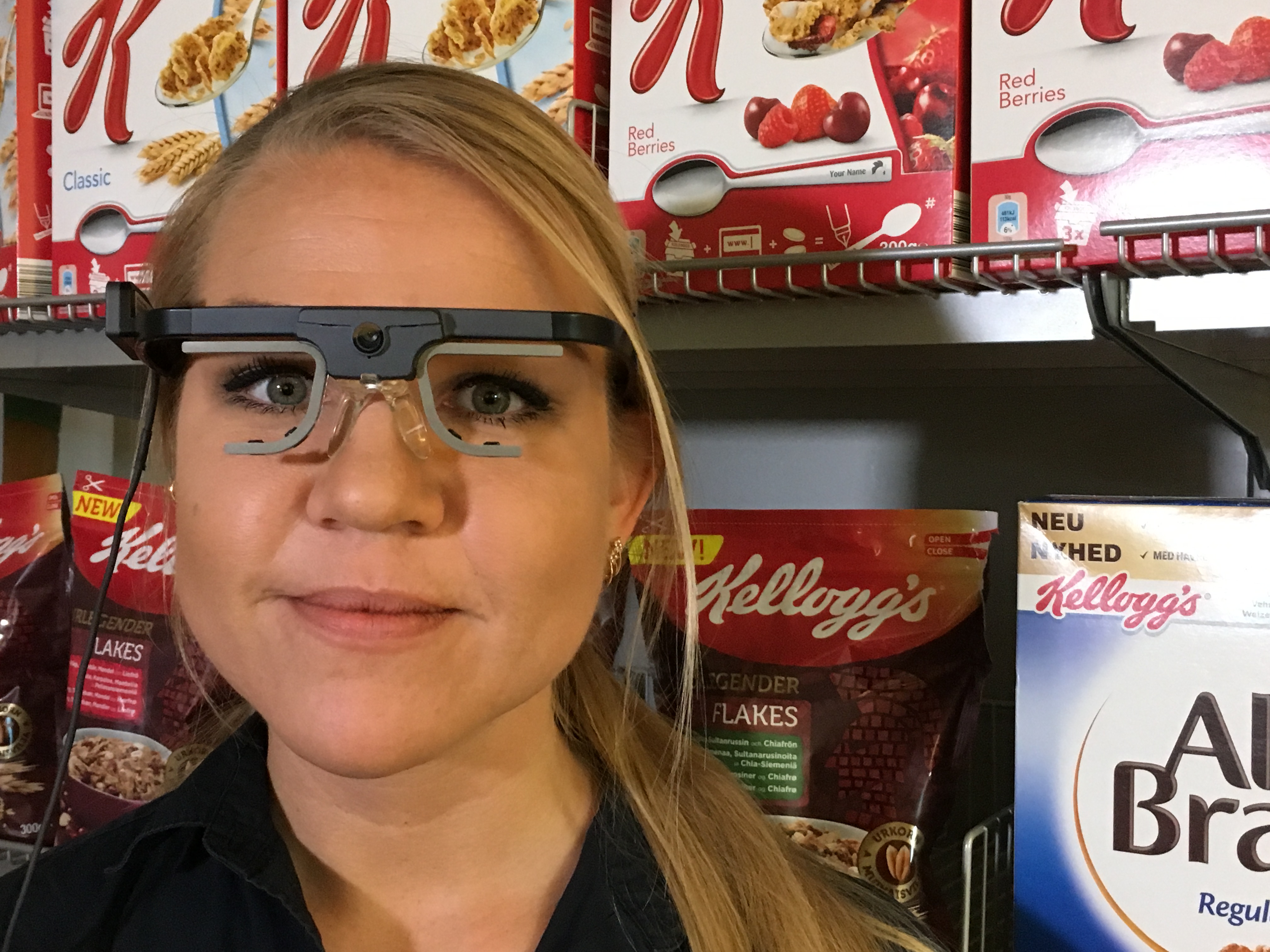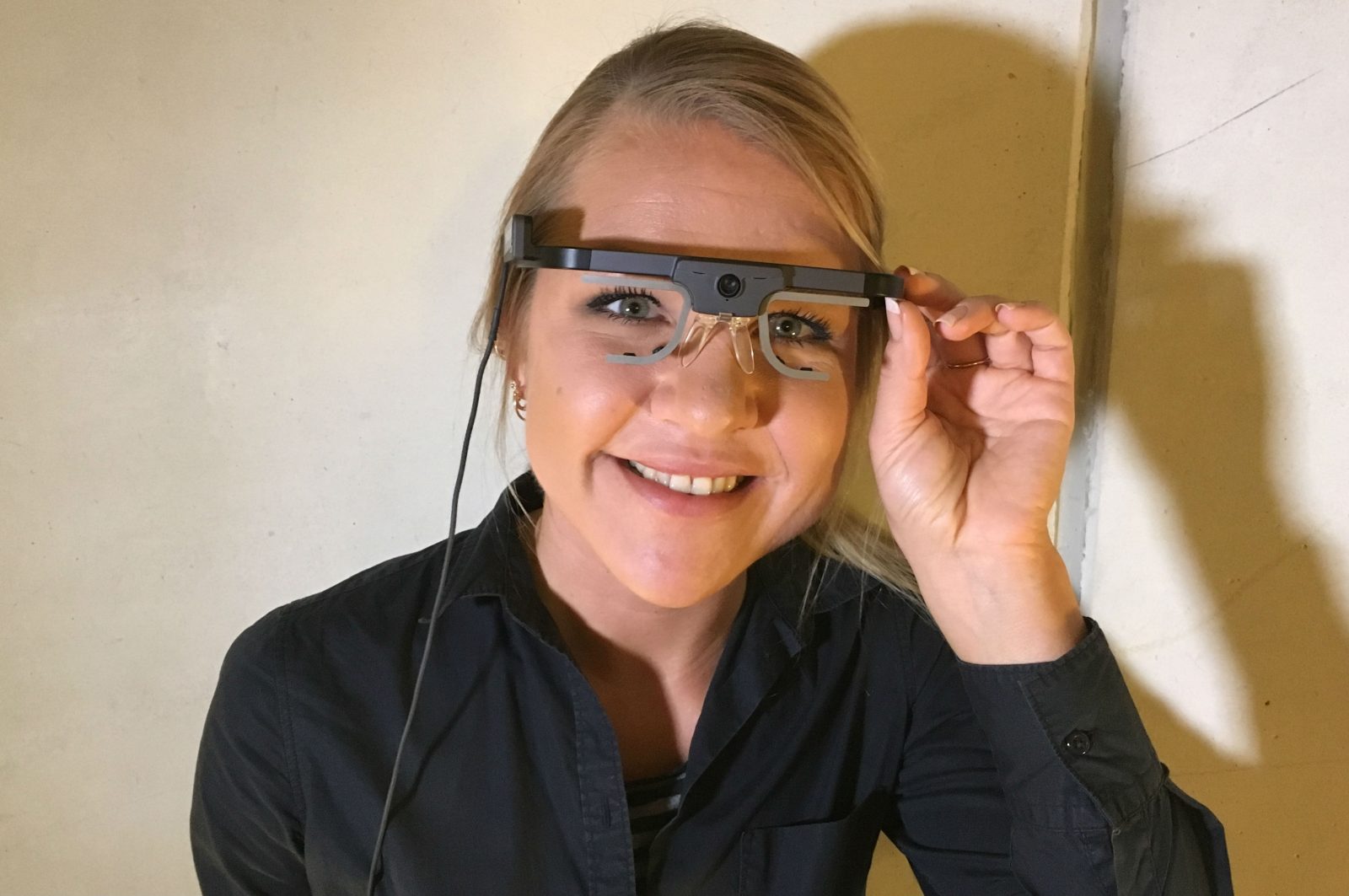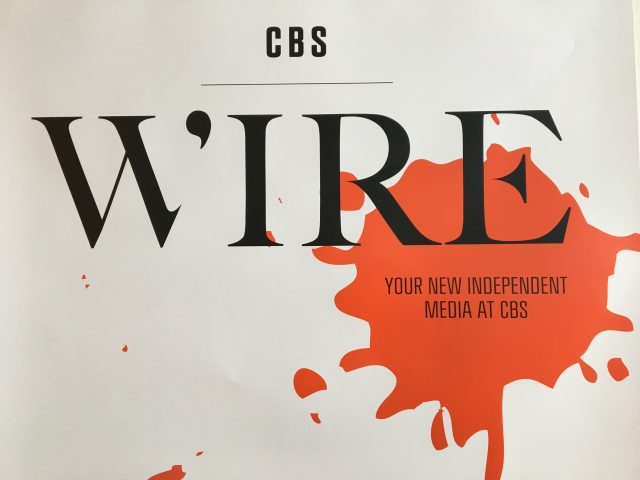I spy with my little eye

In the eye tracking lab at CBS, they have a shelf packed with boxes of morning cereal to simulate a real display from a supermarket. Seidi Suurmets wants to examine the differences between conducting experiments in a real supermarket and in a lab. Photo: Anne M. Lykkegaard.
The space-age, eye-tracking glasses can give insights into what we look at when we go shopping. Combined with brain-imaging techniques, this technology has helped us to understand how humans make decisions. In the future, eye-tracking technology will make shopping even easier.
“This is a skin conductance sensor, which monitors your excitement by measuring the amount of liquid in your skin, and this ear-clip monitors your heartbeat,” explains Ph.D. Fellow, Seidi Suurmets, while applying different electrodes on her test subject, who’s already wearing a fancy pair of eye-tracking glasses to record what she looks at.
The test subject is led into a dark room at CBS and for six seconds the lights are switched on. A wall-to-wall shelf packed with colorful boxes of morning cereals appears, and the subject’s head moves as she looks at the shelf until the lights are turned off again.
Outside the eye-tracking lab, Seidi Suurmets shows the recordings from the glasses and the sensors to the test subject who is part of a larger experiment that Seidi is currently conducting.
“We can learn more about viewing patterns, which is not only interesting for companies and the industry. It also tells us a lot about human behavior in general. And eye tracking is relevant, because we can use it in real life scenarios. Not only in the lab here at CBS,” says Seidi Suurmets, who specializes in consumer neuroscience at the Department of Marketing at CBS.
New eye-tracking technology can prove and disprove old theories
Seidi Suurmets started working with eye tracking when she began her PhD studies back in 2015. And she has been conducting experiments with eye-tracking glasses and monitors ever since.
According to Seidi Suurmets, a lot of the earlier theories about eye movement, shopping behavior and decision making can be either proved or disproved with the newest eye-tracking technology, which allows researchers to gather more precise data. And that’s exactly what she wants to do.
CBS does not own a pair of eye tracking glasses, which is why Seidi Suurmets collaborates with the company, iMotions that lends her the glasses when she needs them for her experiments.
“A pair of eye-tracking glasses costs about a quarter of a million Danish kroner, so I’m lucky that I can borrow a pair from iMotions. I always ride my bike with extra care, when I carry them with me in my bag,” she smiles nervously.
Eye tracking can make shopping easier
Right now, Seidi Suurmets is using the glasses for a project involving the supermarket chain, Kvickly. In the experiment, she makes test subjects shop with the glasses on. You can see how the experiment is carried out in the video below.
“Before (eye-tracking technology red.) we could only get information about people’s behavior in stores by interviewing them afterwards. But people often don’t know why they pick certain items over others. Eye tracking, brain caps and sensors including skin conductance can give us an unbiased insight into these decisions. There are a lot of mental processes going on, which we could only speculate about before,” she says.
For example, an eye tracking study from 2010 revealed that decisive people are good at making decisions from written information. This is because they narrow down the information they get by selecting the most important parts and spend less time looking at the entire text.
This corresponds to what Seidi Suurmets and others have observed in a supermarket. If you want to buy a dairy product with a lot of protein, you’ll start searching for products with specific information on the package and ignore the alternatives.
Indecisive people, on the other hand, absorb the information and evaluate all of it. They also spend more time glancing elsewhere to give themselves time to decide. In a supermarket, they might look at all the different cheeses before deciding which one they want to buy.
Whether you’re a decisive super-shopper or get nervous ticks around the eyes when someone mentions shopping, eye-tracking technology can make shopping so much easier in the future, Seidi argues.
“As customers, we generally don’t want to spend a lot of time shopping. We want to find items fast; we want to check out good deals; and we want to avoid any confusion. Retailers want the customers to return, so ensuring a pleasant shopping experience benefits both parties. For that reason, it can be useful to look into the eye-tracking data and see what can be improved,” she says.
Hunger disturbs our vision
It may appear that eye tracking is only relevant when it comes to our behavior in supermarkets – and that this data only can be used by greedy companies, who want to make us buy their products.
But eye tracking serves many purposes.

Working with Associate Professor, Jesper Clement from the Department of Marketing, Seidi Suurmets did an experiment before Christmas using abstract art and a plate of food.
It might sound like the ingredients for an artistic movie, but Jesper Clement and Seidi Suurmets wanted to examine, how good participants were at pricing a piece of abstract art during different stages of hunger.
To make it even more difficult, a plate of food of food was placed beside the artwork. In this way, Seidi Suurmets and Jesper Clement could check how often and for how long the test subjects glanced at the food.
Their hypothesis was that even though we’re are asked to perform a certain task, our biological needs – such as getting something to eat when we’re hungry – will disturb our performance of those tasks.
“We haven’t had the time to run through all the data, but the experiment gives us an indication that some types of non-conscious processes and our vision can have an influence on how we act when asked to perform different tasks,” Jesper Clement explains.
Seidi Suurmets adds:
“This knowledge allows us to better understand the degree to which we can allocate our attentional resources for cognitive tasks, while there are conflicting bodily goals that disrupt the task,” she says.
Do you know why you buy, what you buy?
Seidi Suurmets will complete her Ph.D. in about a year’s time. Besides working on the project with Kvickly, she has one more project in progress. And it’s somewhat similar to the movie, Inception.
The project involves what is called non-conscious and metaphorical priming – which refers to the way in which people’s responses can be affected without them ever being aware of it.
The hypothesis is that it is possible to trigger people into buying certain products, merely by exposing them to related ads or imagery.
“For example, we can see if people who have seen an advertisement for a fitness center subsequently choose a healthy chicken salad over a bar of chocolate. So even though people don’t know they have been primed, their behavior might be affected,” she explains.
Seidi Suurmets hopes to continue working with eye-tracking technology and consumer neuroscience when she finishes her Ph.D. This technology has certainly caught her eye.
“Eye tracking is cool because it’s still pretty new. There are so many areas that have not yet been looked into, and eye tracking can be a crucial technology in that matter because you can do experiments in real-life scenarios,” she says.

































































































































Comments